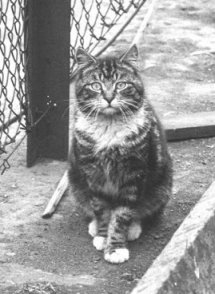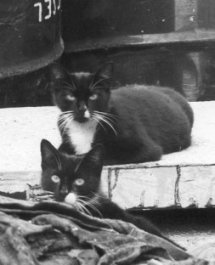
About the Portsmouth Dockyard
Study
|
|
Habitat utilisationPortsmouth Dockyard is an enclosed area, its main walls having been built in 1711 and 1864. It includes basins and docks, and has a land area of about 85 ha. It is an urban habitat, with buildings, netted compounds, and a steam pipe system running in covered trenches. Plant life mainly occurs as small clumps or single plants. The animal life consists of insects such as cockroaches, birds (mainly gulls and pigeons) and mammals (mice and rats). The total population of cats fluctuated around 300, and of adult cats fluctuated around 190. This gives an average density of over 2 cats per hectare, which is very high in comparison with rural populations (where it can be 1 cat per 8 hectares), and suggests a favourable environment. The cats made use of a variety of abundant cover, as shown in the photographs. They were either fed by people, or foraged from skips and bins. I found only limited evidence of the natural food supply being utilised. The cats were generally well-fed. |
|
Home range
|
|
Social behaviourMore information to follow - visit again soon! |
|
Population dynamics
|
|
Activity patternsI collected information on activity patterns during a few long periods of observation of two groups of cats, that covered the whole 24-hour cycle, in both winter and summer. This showed that the cats were not nocturnal, but tended to be active at dawn and dusk (crepuscular) and when when people were active. The cats spent 76 to 84% of their time largely inactive - comparable to the 85% recorded for the Serengeti lion by Schaller. But the extremely low level of activity (0.9%) of one young tom shows just how inactive a cat can be! For detailed information, you can download the "Activity patterns" chapter from my thesis. |
|
Coat colour geneticsAs a result of my article in the Feline Advisory Bureau Bulletin, I was contacted by two people working in field of cat coat colour genetics. I hadn't realised it, but for some years researchers had been "scoring" various cat populations for the frequency of various coat colour genes, and they were desperate to get their hands on detailed information on a sizeable colony recorded over a period of time. More information to follow - visit again soon! |







